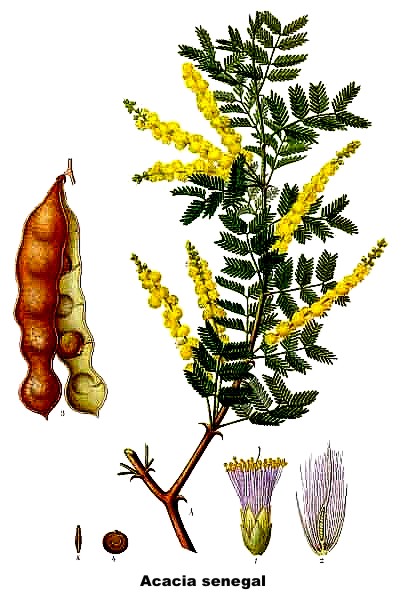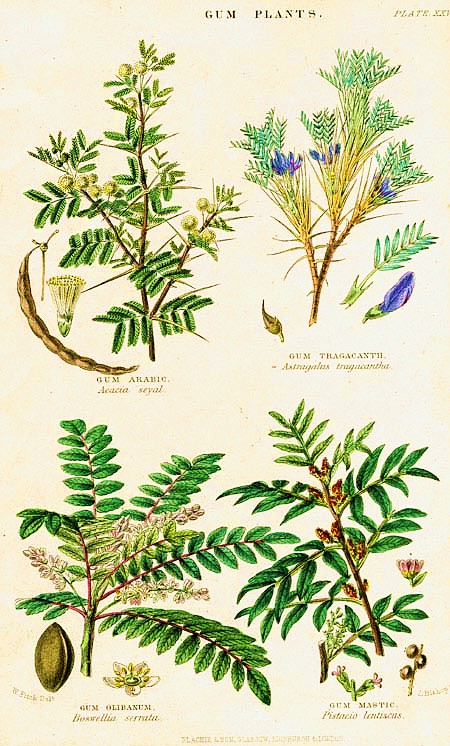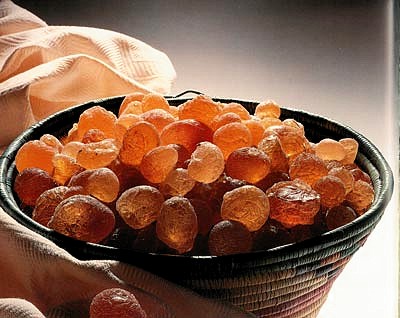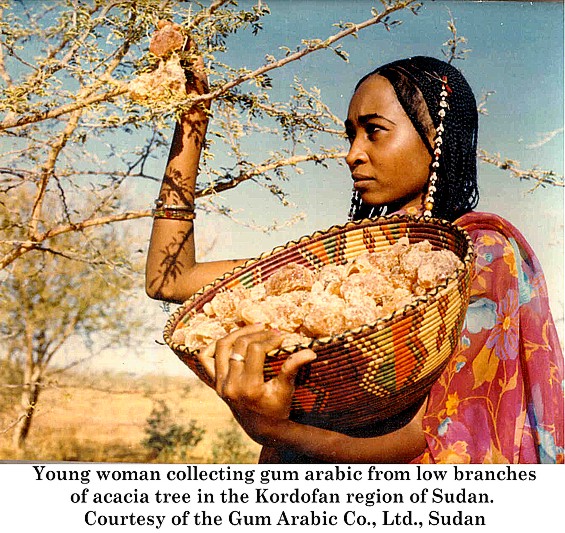Lessico
Gomma arabica
Acacia senegal

Acacia deriva dal latino acacia, derivato dal greco akakía, probabilmente di origine egiziana. La forma popolare corrispondente è gaggìa, termine oggi abitualmente usato per indicare tutt'altra pianta, la Robinia pseudoacacia, pianta arborea della famiglia Leguminose o Papilionacee, detta anche robinia dal nome dell'erborista parigino Jean Robin (1550-1628) che la importò dal Canada, essendo infatti originaria dell'America Settentrionale e naturalizzata in Europa a partire dal XVII secolo.
Acacia è un genere di piante della famiglia Mimosacee, comprendente oltre 500 specie diffuse nelle zone calde e aride dei tropici, particolarmente in Australia, America, Africa, dove formano boscaglie rade. Sono alberi o arbusti spinosi o inermi, con foglie composte bipennate o ridotte al solo picciolo simile a una foglia (fillodio). I fiori sono piccoli, riuniti in capolini formanti infiorescenze diverse; gli stami sono assai allungati e i frutti sono per lo più dei legumi. Le comuni mimose, piante ornamentali a fiori in genere gialli, coltivate nella Riviera Ligure, appartengono a questo genere (Acacia dealbata, Acacia baileyana). Largamente usate sono l'Acacia senegal, l'Acacia catechu e l'Acacia suma.
L'Acacia senegal, a fiori giallo-pallidi, originaria dell'Africa tropicale, fornisce la gomma arabica, sostanza formata per l'80% di arabina, pentosano che per idrolisi fornisce vari monosaccaridi. La gomma arabica è usata in varie industrie, tra cui la tessile e quella dei liquori; in farmacologia è sfruttata come emolliente e protettivo della mucosa digerente e come correttivo dell'azione irritante di molti farmaci.
L'Acacia catechu, comune in India e in Birmania a quote non inferiori ai 1000 m, e l'Acacia suma, originaria dell'India meridionale, forniscono il catecù, o terra cattù, sostanza che contiene dal 2 al 20% di catechina, usata come astringente e antisettico in forme diarroiche di varia origine.
Il legno delle acace è molto usato soprattutto per la sua durezza, compattezza e resistenza longitudinale alla pressione; ha grana fine, è pesante ma elastico, per cui si presta per essere lavorato al tornio. Inattaccabile dai tarli, è molto resistente all'aria e all'acqua; conserva a lungo la colorazione ricevuta e viene lucidato con facilità e ottimi risultati. Dalla corteccia si ricava tannino.
Gomme vegetali

Quattro
produttori di gomme
gomma arabica - gomma adragante![]()
incenso![]() - mastice
- mastice![]()
Le gomme vegetali sono costituite da composti macromolecolari del gruppo dei carboidrati e si disciolgono in acqua formando soluzioni colloidali più o meno dense secondo la concentrazione e la natura della gomma, mentre sono insolubili in alcol e negli altri solventi organici. La più nota è la gomma. arabica, ottenuta da alcune specie del genere Acacia, in particolare da Acacia senegal.

Gomma arabica
La gomma arabica si presenta in granuli gialli o appena giallognoli e semitrasparenti nei tipi più pregiati. Le zone di maggior produzione sono il Senegal e la zona sudanese della valle del Nilo. Per ottenerla dalle piante si asportano dal tronco delle strisce di corteccia avendo cura di non intaccare il legno sottostante: dopo qualche decina di giorni la zona scortecciata appare coperta da uno straterello di gomma; il raccolto si ripete di tempo in tempo. Oltre che per preparare la soluzione al 20% circa usata come adesivo, ma in buona parte oggi sostituita dalle gomme artificiali a base di destrina e di amido, la gomma arabica trova largo impiego nella preparazione di pasticche gommose in campo dolciario e nell'industria farmaceutica, nella quale viene inoltre usata per dare compattezza alle compresse e alle pastiglie.
La gomma adragante, ricavata da alcune specie di astragalo, si presenta in piastrine bianche o giallognole; in acqua si rigonfia e forma poi una soluzione fortemente mucillaginosa. Viene usata nella tecnica farmaceutica analogamente alla gomma arabica e inoltre come addensante nella preparazione di salse e sciroppi, nella finitura e nella tintura a stampa dei tessuti, ecc. Di qualità meno pregiata sono le gomme ricavate da alcune specie del genere Sterculia, note in commercio con il nome di gomma karaya, e quelle ricavate da Anogeissus latifolia, note come gomma ghati.

Gum arabic, a natural gum also called gum acacia, is a substance that is taken from two sub-Saharan species of the acacia tree, Acacia senegal and Acacia seyal. It is used primarily in the food industry as a stabilizer, but has had more varied uses in the past, including viscosity control in inks. Its E number is E414.
Gum arabic is a complex mixture of saccharides and glycoproteins, which gives it its most useful property: it is perfectly edible. Other substances have replaced it in situations where toxicity is not an issue, as the proportions of the various chemicals in gum arabic vary widely and make it unpredictable. Still, it remains an important ingredient in soft drink syrups, "hard" gummy candies like gumdrops, marshmallows, M & M's chocolate candies, and most notably, chewing gums. For artists it is the traditional binder used in watercolor paint, and is used in photography for gum printing. Pharmaceuticals and cosmetics also use the gum, and it is used as a binder in pyrotechnic compositions. It is an important ingredient in shoe polish. It is also used often as a likable adhesive on postage stamps and cigarette papers. Printers employ it to stop oxidation of aluminium printing plates in the interval between processing of the plate and its use on a printing press.
The substance is grown commercially throughout the Sahel from Senegal and Sudan to Somaliland.
Gum arabic is used as a binder for watercolor painting because it dissolves easily in water. Pigment of any color is suspended within the gum arabic in varying amounts, resulting in watercolor paint. Water acts as a vehicle or a diluent to thin the watercolor paint and helps to transfer the paint to a surface such as paper. When all moisture evaporates, the gum arabic binds the pigment to the paper surface.
The historical photography process of gum bichromate photography uses gum arabic to permanently bind pigments on paper. Ammonium or potassium dichromate is mixed with gum arabic and pigment to create a photographic emulsion, sensitive to ultraviolet light.
Gum arabic is also used to protect and etch an image in lithographic processes. Ink tends to fill into whitespace on photosensitive aluminium plates if they don't receive a layer of gum. In stone lithography the gum etch is used to etch the most subtle gray tones. Phosphoric acid is added in varying concentrations to the gum arabic to etch the darker tones up to dark blacks. Multiple layers of gum are used after the etching process to build up a protective barrier that ensures the ink does not fill into the whitespace of the image being printed.
Although from the 1950s to the early 1990s Sudan accounted for roughly 80% of gum arabic production, today that figure is under 50%. However it is still the world's largest single producer, and the production of gum arabic is heavily controlled by the Sudanese government.
The connection between Sudan and Osama bin Laden brought the otherwise innocuous gum to public consciousness in 2001, as an urban legend arose that bin Laden owned a significant fraction of the gum arabic production in Sudan and that therefore one should boycott products using it. As a result, some food producers, such as Snapple, renamed the ingredient to "gum acacia" on their labels.
This story took on somewhat significant proportions, mostly thanks to an article in The Daily Telegraph a few days after the September 11 attacks, which echoed this claim. Eventually, the State Department issued a release stating that while Osama bin Laden had once had considerable holdings in Sudanese gum arabic production, he divested himself of these when he was expelled from Sudan in 1996.
In a press conference held at the Washington Press Club on 30 May 2007, John Ukec Lueth Ukec, Sudan's ambassador to the United States, threatened to stop exportation of gum arabic from his country if sanctions were imposed. The sanctions proposed by the United States were a political response from the United States to the alleged connection between the government of Sudan and the Janjaweed militia group. Ukec made his speech surrounded by Coca-Cola products, although other sodas use gum arabic as an emulsifier as well.
John Ukec Lueth Ukec was quoted at the Washington press conference, "I want you to know that the gum arabic which runs all the soft drinks all over the world, including the United States, mainly 80 percent is imported from my country," which he said after raising a bottle of Coca-Cola. According to the Washington Post, a reporter then asked if Sudan was threatening to "stop the export of gum arabic and bring down the Western world." To which Ukec replied, "I can stop that gum arabic and all of us will have lost this," and gestured to the Coke bottle.
Gum arabic is also used as a water soluble binder in firework composition. Gum arabic reduces the surface tension of liquids, which leads to increased fizzing in carbonated beverages. This can be exploited in what is known as a Diet Coke and Mentos eruption.